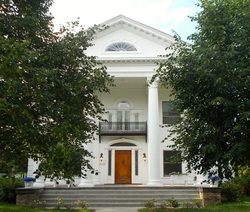(Not Just Victorian) Flatbush tour
Stunning houses in Prospect Park South/Ditmas Park, Caribbean flavor, Brooklyn's oldest church, and Flatbush Avenue's revived/revised historic theaters
 Mansion, Albemarle Road Mansion, Albemarle Road
The pieces of the Flatbush neighborhood south of Prospect Park, known to real estate agents as Victorian Flatbush (aka Ditmas Park and Prospect Park South, which are distinct segments), contain enormous contrasts.
We'll see leafy streets with large Victorian houses, part of country-in-city early 20th century development. We'll visit streets crammed with pre-war apartment buildings, and bustling, raucous shopping streets, serving people who've come to Brooklyn from places afar as Pakistani and Haiti. The tour includes a couple of historic districts, including the micro-enclave of Albermarle Terrace and Kenmore Terrace, the spacious Ditmas Park, and the astounding Prospect Park South, which, as a couple of photos below show, is a fantastic place to visit before Halloween. From Joseph O'Neill's novel Netherland: We turned off Church, and in an instant that raucous Caribbean boulevard, with its ninety-nine-cent stores and discount clothing outlets... had given way to a neighborhood unlike any other I'd seen in New York. It is an interesting mix, with a complex history, in some cases dating back to early Brooklyn, with landmarks such as the Flatbush Dutch Reformed Church. The neighborhood grew in stages: farmland became development sites at the turn of the 20th century. After the subway moved south in the second decade of the century, hundreds of apartment buildings were constructed. The new population fueled new retail outlets (an art deco Sears!) and theater, which have been turned into churches, retail outlets, or lovingly restored (see the Kings Theatre below). Post war suburbanization and immigration meant Flatbush's largely Jewish population--which once supported bakeries like Ebinger's--was be replaced significantly by newcomers from the West Indies. So the Flatbush Avenue spine has a pronounced Caribbean flavor. The far west edge of the neighborhood is Coney Island Avenue, with a mix of ethnic groups, including Pakistani, Afghan, Russian, as well as mosques and synagogues. Gentrification has lapped outward to Flatbush, with its attendant strains. Retail change is notable less on Flatbush but on Cortelyou Road in what many people call Ditmas Park, home to new restaurants, cafes, and retail establishments. There's an interesting story behind those changes, too. Note: I sometimes lead shorter (one-hour) tours of Prospect Park South only, combined with an indoor visit to the "Japanese House," as part of a package tour from the New York Adventure Club, which offers numerous tours not led by me. This tour does not go to the former site of Ebbets Field, which is a little far afield, but we could get there by bus/subway/taxi, or take a longer walk into Prospect Lefferts Gardens and south Crown Heights.. That said, there's virtually no sign of the past there. Wondering about the Sophie's Choice connection to the neighborhood? Yes, we'll pass by the once-pink house used in the film. But the filmmakers cheated a bit: that house, located squarely in Prospect Park South, is a little farther from the Parade Grounds than that described in the book. Also note that we see only a portion of the much larger Flatbush/Midwood neighborhood. We can see more if we add time. |
Distance from Midtown Manhattan: 30-40 minutes by subway
Cost: see fees here Basic tour length: 2.5 hours (see fees) Starting place: Varies, but typically Q/B at Church Avenue Ending place: Varies, but typically a Q train stop Highlights: History, architecture, immigration, ethnic change Before tour: Ask After tour: Snack/lunch on Cortelyou Road Potential tour extensions with me: Brooklyn 101 Why I like leading this tour: Victorian Flatbush is stunning, but a tour limited to blocks with standalone houses/mansions can't do justice to the larger context. So we put them together. |